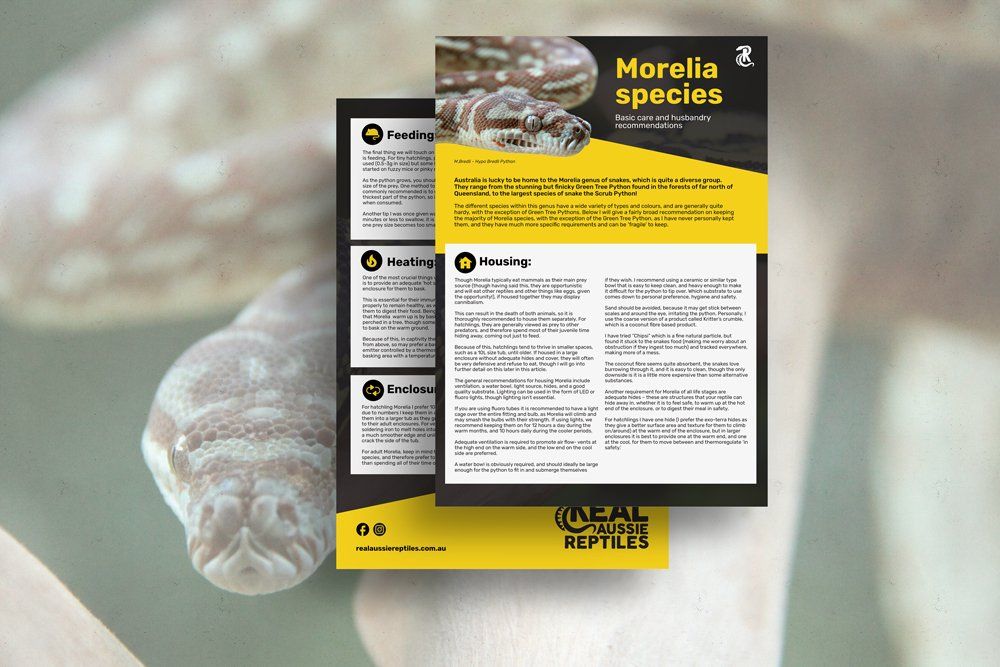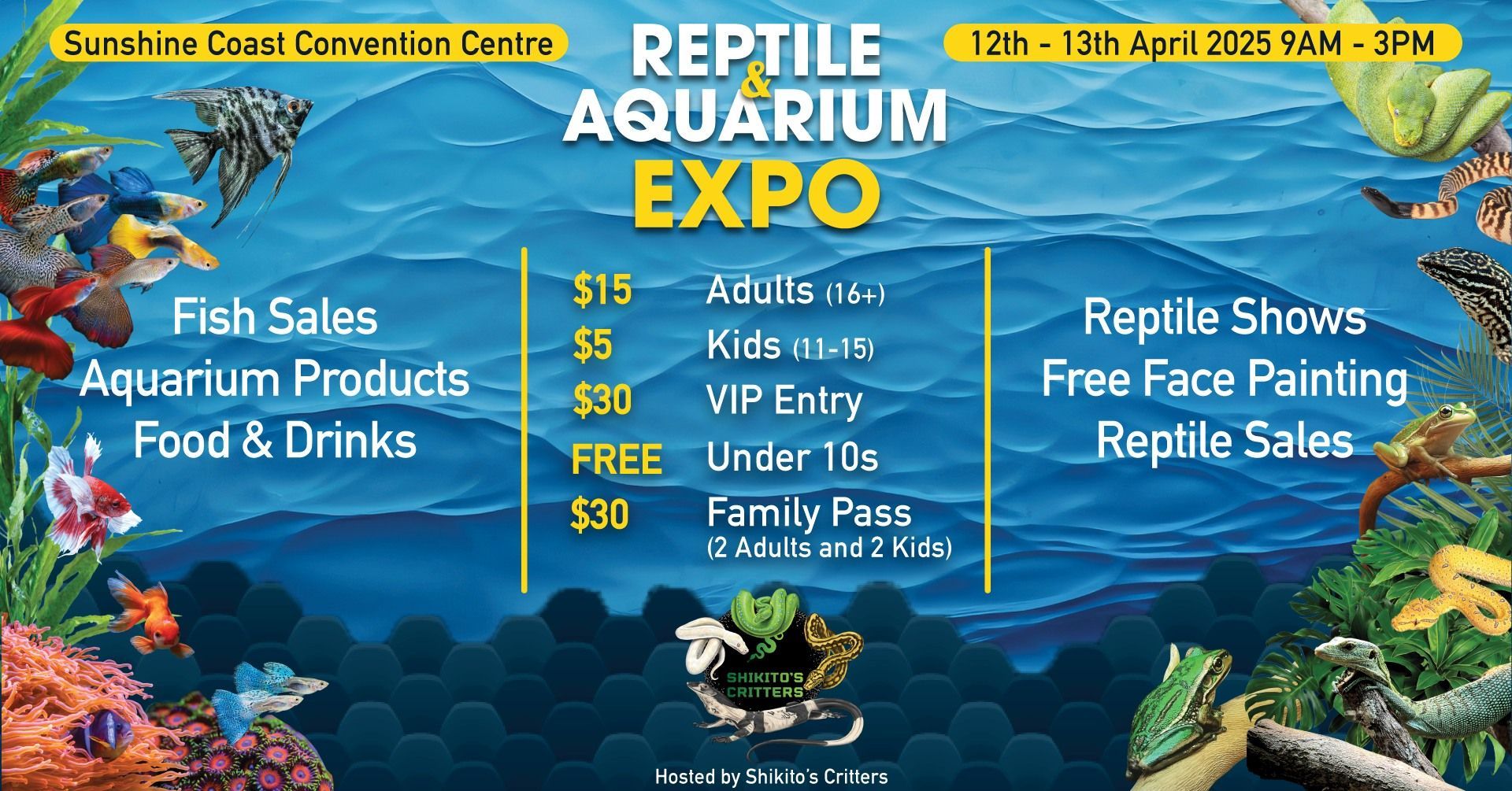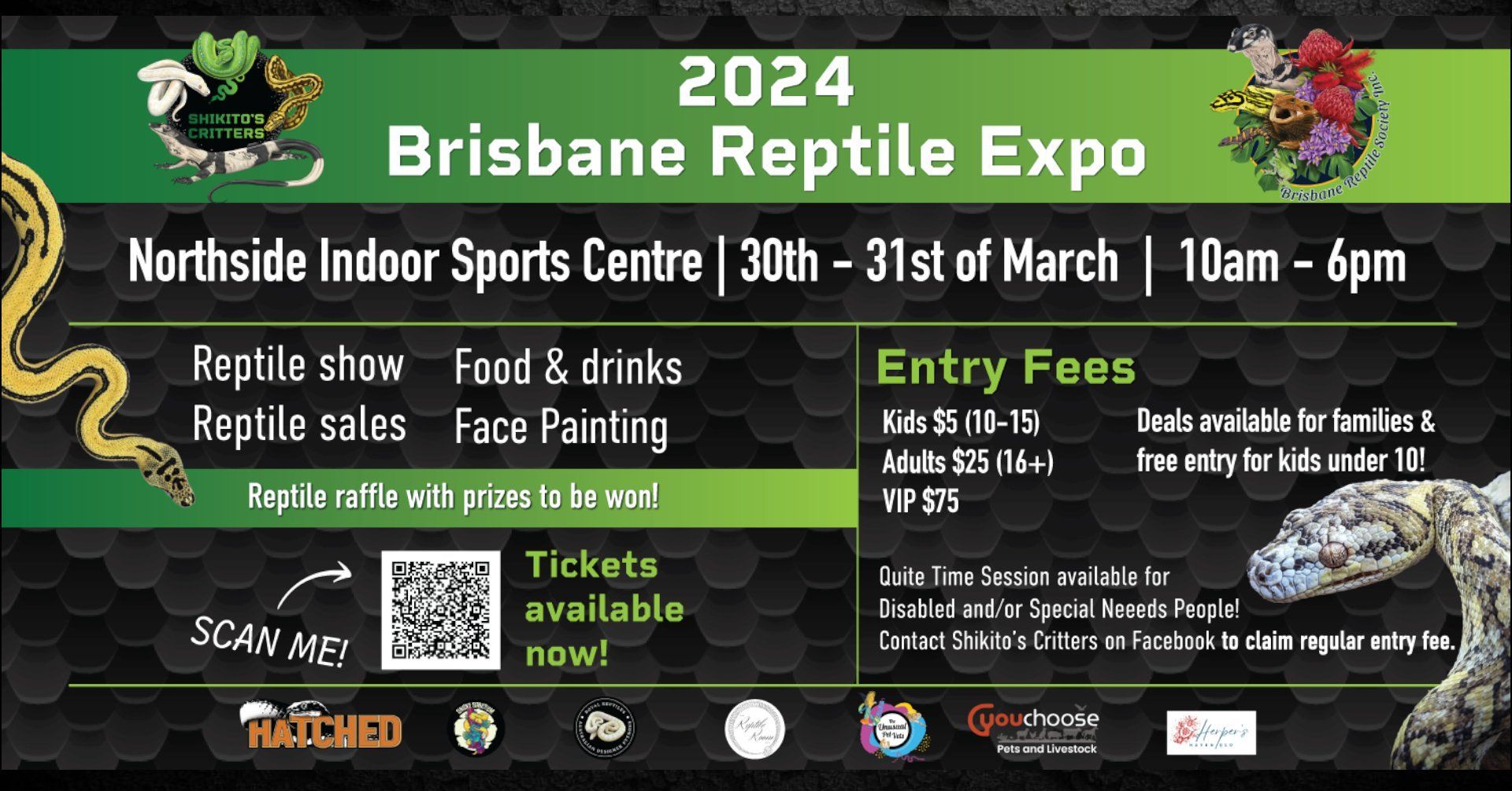Morelia Species Care Sheet
Basic care and husbandry recommendations for keeping Morelia species, with a free PDF download of the Morelia Species Care Sheet.
Australia is lucky to be home to the Morelia genus of snakes, which is quite a diverse group.
Morelia in our planned pairings include:
- Jungle Carpet Python
- Bredli Carpet Python
- Rough Scale Python
Morelia range from the stunning but finicky Green Tree Python found in the forests of far north of Queensland, to the largest species of snake the Scrub Python!
The different species within this genus have a wide variety of types and colours, and are generally quite hardy, with the exception of Green Tree Pythons. Below I will give a fairly broad recommendation on keeping the majority of Morelia species, with the exception of the Green Tree Python, as I have never personally kept them, and they have much more specific requirements and can be ‘fragile’ to keep.
1. Housing
Though Morelia typically eat mammals as their main prey source (though having said this, they are opportunistic and will eat other reptiles and other things like eggs, given the opportunity!), if housed together they may display cannibalism. This can result in the death of both animals, so it is thoroughly recommended to house them separately.
For hatchlings, they are generally viewed as prey to other predators, and therefore spend most of their juvenile time hiding away, coming out just to feed. Because of this, hatchlings tend to thrive in smaller spaces, such as a 10L size tub, until older. If housed in a large enclosure without adequate hides and cover, they will often be very defensive and refuse to eat, though I will go into further detail on this later in this article.
The general recommendations for housing Morelia include ventilation, a water bowl, light source, hides, and a good quality substrate. Lighting can be used in the form of LED or fluoro lights, though lighting isn’t essential. If you are using fluoro tubes it is recommended to have a light cage over the entire fitting and bulb, as Morelia will climb and may smash the bulbs with their strength. If using lights, we recommend keeping them on for 12 hours a day during the warm months, and 10 hours daily during the cooler periods.
Adequate ventilation is required to promote air flow- vents at the high end on the warm side, and the low end on the cool side are preferred. A water bowl is obviously required, and should ideally be large enough for the python to fit in and submerge themselves if they wish. I recommend using a ceramic or similar type bowl that is easy to keep clean, and heavy enough to make it difficult for the python to tip over. Which substrate to use comes down to personal preference, hygiene and safety.
Sand should be avoided, because it may get stick between scales and around the eye, irritating the python. Personally, I use the coarse version of a product called Kritter’s crumble, which is a coconut fibre based product. I have tried “Chipsi” which is a fine natural particle, but found it stuck to the snakes food (making me worry about an obstruction if they ingest too much) and tracked everywhere, making more of a mess. The coconut fibre seems quite absorbent, the snakes love burrowing through it, and it is easy to clean, though the only downside is it is a little more expensive than some alternative substances.
Another requirement for Morelia of all life stages are adequate hides – these are structures that your reptile can hide away in, whether it is to feel safe, to warm up at the hot end of the enclosure, or to digest their meal in safety. For hatchlings I have one hide (I prefer the exo-terra hides as they give a better surface area and texture for them to climb on/around) at the warm end of the enclosure, but in larger enclosures it is best to provide one at the warm end, and one at the cool, for them to move between and thermoregulate ‘in safety.’
2. Enclosure size
For hatchling Morelia I prefer 10L tubs to house them, and due to numbers I keep them in a rack system, and upgrade them into a larger tub as they grow, before moving them to their adult enclosures.
For ventilation in a tub, I use a soldering iron to melt holes into the plastic - I Find it leaves a much smoother edge and unlike drilling, is not likely to crack the side of the tub. For adult Morelia, keep in mind that they are an arboreal species, and therefore prefer to spend time climbing, rather than spending all of their time on the ground.
It gets a little trickier to provide a blanket recommendation for adult Morelia as they vary in size from 1.2m to 8m in length! For smaller Morelia species, or those that are quite inactive like the Green Tree Python, you may be able to house them in a 90cm long x 60cm deep x 90cm high enclosure, particularly if you get them out to stretch periodically. Others would benefit with the same depth and height, but with the addition of more length- 150cm or even up to 240cm in length for the Scrub Python.
3. Heating
One of the most crucial things when housing pet snakes is to provide an adequate ‘hot spot’ or warm end of the enclosure for them to bask. This is essential for their immune system to function properly to remain healthy, as well as being critical for them to digest their food.
Being arboreal, the main way that Morelia warm up is by basking in the sunlight whilst perched in a tree, though sometimes they will come down to bask on the warm ground. Because of this, in captivity they often seem to prefer heat from above, so may prefer a basking light or ceramic heat emitter controlled by a thermostat.
I aim to maintain a basking area with a temperature of 32-34’C (perhaps a little lower for Diamond carpet pythons). It is important to use a separate digital thermometer at the basking site to ensure the thermostat is working correctly, and that the desired temperature is reached. For hatchlings in a rack system before they upgrade to a full enclosure, I use a heat cord connected to a thermostat to control the temperature, or for a single hatchling, you can use a heat cord. I generally heat 1/3 of the enclosure and the cool area sits at the ambient room temperature, so the snakes can thermoregulate themselves as needed
4. Feeding
The final thing we will touch on in this particular caresheet, is feeding. For tiny hatchlings, pinky mice may need to be used (0.5-3g in size) but some larger hatchlings may be started on fuzzy mice or pinky rats.
As the python grows, you should gradually increase the size of the prey. One method to determine prey size that is commonly recommended is to use a rodent roughly 1.5x the thickest part of the python, so it leaves a noticeable bulge when consumed. Another tip I was once given was if it takes the python 5 minutes or less to swallow, it is time to up the feeds!
When one prey size becomes too small, I’ll often do a few feeds (eg 5) with two of the prey items, one immediately after the other, before upgrading to the next rodent size. For adult Morelia, I try to avoid feeding fatty prey- for example, XL or Jumbo rats often seem to have the same muscle and bone amount as a standard large rat, but the extra weight is purely fat.
This extra fat certainly certainly isn’t a good thing, particularly when captive snakes are already more prone to obesity. Instead, I’d recommend sourcing rabbits, or intermittently use appropriately sized quail or chickens, which are quite lean. I generally feed hatchlings every 5-7 days, sub-adults weekly, and adults fortnightly.





